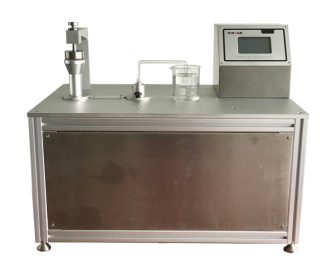
Non woven fabric compression water absorption tester
Used to compare the water absorption of non manufactured fabric materials, but not to simulate the actual usage conditions of the final product.
Testing principle:
This method tests the liquid absorption of fabrics under constant pressure. Place the sample on a specialized porous plate, where the liquid level in the storage tank is lower than the upper surface of the porous plate through a siphon. Determine the pressure absorption of the fabric by measuring the change in the mass of the storage tank over time.
Testing standards:
According to GB/T 24218.12-2012, determine the compressive water absorption of non-woven fabrics
Related terms:
Large absorption mass (Af)
The mass of liquid absorbed by the sample up to time Tf, in grams. The change in the mass of liquid absorbed by the sample from Tf to 5s before Tf is less than 1% of the mass of liquid absorbed at Tf.
Compression absorption capacity (DAC)
The ratio of the large absorption mass Af to the sample mass m, in grams per second.
Large absorption rate (MAR)
The significant change in the mass of absorbed liquid per unit time interval, measured in grams per second.
Test steps:
1. Use hydrophobic double-sided adhesive tape to stick the hydrophobic foam pad on the hammer so that the foam pad can be replaced at any time.
2. Prepare 5 specimens with a diameter of (55 ± 1) mm to be cut from the same specimen (which must be moistened first).
3. Add water to the storage tank to ensure that the water surface is above the bottom of the glass conduit; Add water from one end of the funnel to fill the tube with water, then block one end of the glass tube with your hand and add water into the funnel with the other hand until the water surface is level with the surface of the funnel. Then cover the porous glass plate with the top of the funnel, wipe the surface of the porous glass plate with a dry and clean cloth, and place the tested sample on the porous glass plate, covering it with a cylindrical hammer; Adjust the outer surface of the upper end of the horizontal section of the U-shaped pipe to be (40 ± 0.5) mm higher than the liquid level in the storage tank.
4. Power on
5. Select language and enter the testing interface
6. Fill in the sample number, fill in the quality of the tested sample, select the standard absorption rate (or high absorption rate), and click the test button.
7. Click the start button to start the experiment
8. The experiment is over, click the save button
9. Click the data button on the left side of the display screen to view the saved data
10. Calibration
If testing is frequent, calibration is required every two days. Calibration includes two parts: porous plate flow rate calibration and electronic balance calibration. Click the calibration button on the left side of the display screen and select porous plate calibration.
11. Measurement method:
Extract 11 milliliters of deionized water using a syringe, install a plastic fixture at the top of the funnel, and then pour 11 milliliters of deionized water into the fixture. Check if the flow rate of the porous plate on the page is within the range of 2.5-3.5g/s.
12. Electronic balance calibration
Click the calibration button on the left side of the display screen, select Electronic Balance Calibration, and then follow the interface prompts to operate.
Prev: Glove integrity tester